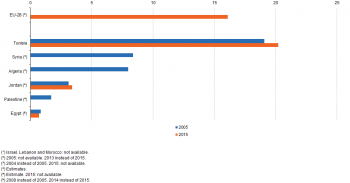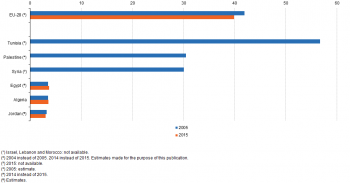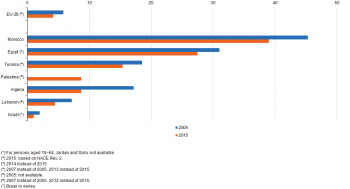Archive:European Neighbourhood Policy - South - agriculture statistics
- Data extracted in August 2016. Most recent data: Further Eurostat information, Main tables and Database. Planned article update: February 2018.
This article is part of an online publication and provides data on agricultural statistics for nine of the countries that form the European Neighbourhood Policy-South (ENP-South) region, namely, Algeria, Egypt, Israel, Jordan, Lebanon, Morocco, Palestine [1], Syria and Tunisia; no data are available for Libya. The article provides an overview of the key characteristics of agriculture in these countries and in the European Union (EU), providing statistics on the average size of agricultural holdings (hereafter referred to as farms) and their output, including crop and livestock production.

(hectares)
Source: Eurostat (ef_kvftaa) and (med_ag1)

(% of total area)
Source: Eurostat (apro_acs_a), (demo_r_d3area), (med_ag1) and (med_ps111)

(%)
Source: Eurostat (lfsa_egana), (lfsa_egan2) and (med_ps414)

(%)
Source: Eurostat (aact_eaa01) and (med_ag50)

(million EUR)
Source: Eurostat (aact_eaa01) and (med_ag50)

(including rice), 2015
(thousand tonnes)
Source: Eurostat (apro_acs_a) and (med_ag2)

(thousand heads)
Source: Eurostat (apro_mt_lscatl), (apro_mt_lspig), (apro_mt_lssheep) and (med_ag33)
Main statistical findings
Land use and structure of farms
Farms in the ENP-South countries are, on average, smaller than farms in the EU
The average size of farms in the EU-28 was 16.1 hectares of utilised agricultural area (UAA) in 2013. This average masks considerable differences between, for example, arable farms specialised in growing cereals such as wheat (which may occupy thousands of hectares on fertile lowland plains) and subsistence farmers working with only a couple of hectares of land.
In 2015, the average farm size in the ENP-South countries was generally lower than in the EU-28, ranging from 0.7 hectares per farm in Egypt (2014 data) to 3.4 hectares in Jordan; note that recent data for Algeria and Syria are not available, although these two countries recorded averages of 8.0 and 8.4 hectares per farm in 2004. By contrast, the average size of farms in Tunisia was well above this range (20.2 hectares per farm); as such, it was the only ENP-South country to report that its farms were, on average, larger than in the EU-28 (see Figure 1). Some of these differences in average farm size may be linked to the fragmented nature of land ownership in some ENP-South countries, as well as a higher proportion of the population living in often remote, rural areas, with a largely subsistence lifestyle.
Furthermore, the development of specific types of farming in the ENP-South countries may be limited by topographic and climatic conditions. Indeed, in 2014 or 2015 less than 4.0 % of the total land area of Egypt, Algeria and Jordan was used for agriculture (see Figure 2). Recent data are not available for the other ENP-South countries, but older data suggest that the shares in Tunisia, Palestine and Syria were of a similar order of magnitude to that in the EU-28 (39.9 %, 2014 data).
Employment
Agriculture, forestry and fishing generally accounted for a much higher share of the workforce in the ENP-South countries than in the EU-28
Figure 3 shows an analysis of the structure of employment for 2005 and 2015. Within the EU-28, the share of agriculture, forestry and fishing in total employment (for those aged 15–64) fell from 5.8 % in 2005 to 4.2 % by 2015.
The employment share of agriculture, forestry and fishing in the ENP-South countries was generally much higher than in the EU-28, although the share in Lebanon (4.5 %, 2012 data) was comparable to the EU-28 average, while a lower proportion of the Israeli workforce was occupied in these activities (1.1 % in 2015). At the other end of the range, close to two fifths of the workforce in Morocco and more than a quarter of the workforce in Egypt (2014 data) were employed in agriculture, forestry and fishing, while more than one in seven of the workforce in Tunisia (2013 data) also worked in these activities, as did 8.7 % of the workforce in Algeria and Palestine.
The share of the workforce in agriculture, forestry and fishing fell between 2005 and 2015 in each of the ENP-South countries for which data are available (as it did in the EU-28). The largest contraction (in percentage point terms) was recorded for Algeria, where the proportion of people working in agriculture, forestry and fishing fell by 8.5 points, as the number of persons employed in this sector almost halved; there was also a relatively fast reduction in the share of agriculture, forestry and fishing in total employment in Morocco (down 6.3 points).
Agricultural inputs and output
Less-intensive farming in the ENP-South countries
The use of agricultural inputs (such as feeding stuffs, pesticides and herbicides) varies annually, in part reflecting changing needs due to climatic conditions or threats from disease or pests. The value of such intermediate consumption was equivalent to half (51.4 %) of the value of agricultural production in the EU-27 in 2003, and by 2013 this ratio had risen to three fifths (59.7 %) in the EU-28.
In all of the ENP-South countries for which data are available, except Israel (65.8%), the value of intermediate consumption in 2013 was equivalent to a lower share of agricultural output than in the EU-28 (see Figure 4). The lowest ratios were recorded for Algeria, Egypt (2010 data) and Morocco.
The value of agricultural output (in euro terms) stood at EUR 426 billion in the EU-28 in 2013. Among the ENP-South countries for which data are available, the highest value of agricultural output was recorded in Egypt (EUR 27.1 billion, 2010 data), which was equivalent to 7.4 % of the EU-28 total (in the same year). Although the length of the time series presented in Table 1 varies considerably between countries, rapid increases in the value of agricultural output (in current prices) among the ENP-South countries were witnessed in Algeria and Egypt (where output more than doubled), Israel and Morocco.
Crop and animal production
Crop yields and production volumes often closely linked to rainfall patterns
The ENP-South countries are often characterised as being arid areas of unfertile soil, covered with rock and sand. Nevertheless, there are pockets of more fertile land within each of the ENP-South countries, particularly along river valleys or close to the coast. While the winter months often see relatively high levels of rainfall, some regions receive little or no rainfall during the summer. The variability in rainfall patterns can play a considerable role in determining the success or failure of each harvest. This variability is reflected in the figures for harvested production.
In 2015, the largest producers of cereals among the ENP-South countries were Egypt (2014 data) and Morocco, with 23.7 million tonnes and 11.6 million tonnes of output respectively. Their main cereal crops were wheat (both countries), barley (Morocco) and grain maize (Egypt) — see Table 2.
Large population of sheep and goats in ENP-South countries
While farming of livestock in the ENP-South countries is shaped by climatic and topographic conditions, cultural and religious traditions also affect the types of animals that are kept. Many subsistence farmers in the ENP-South countries keep a small number of animals on their farm which may be used for eggs, milk, wool/hides, as well as for their meat.
The population of sheep and goats in most of the ENP-South countries was relatively high. This may, at least in part, be linked to the ability of these animals to survive in arid conditions (whereas the ideal conditions for rearing cattle include a plentiful supply of pasture). Pig farming is almost non-existent in ENP-South countries, reflecting the religious practices of their majority Muslim or Jewish populations.
Table 3 provides a breakdown of animal populations for the EU-28 and the ENP-South countries in December 2015. Apart from the obvious difference concerning pig farming, there was also a considerable difference in the number of cattle raised in the EU-28 and the ENP-South countries; the total number of cattle across the ENP-South countries for which data are available (December 2014 data for Egypt, December 2013 data for Palestine, no data for Lebanon or Syria) equated to just 13 % of the total number in the EU-28. No recent data are available for sheep and goats in the EU-28, but the number of sheep in the ENP-South countries was around three quarters of the level in the EU-28 and it is estimated that there were many more goats in the ENP-South countries than in the EU-28.
Data sources and availability
The data for ENP-South countries are supplied by and under the responsibility of the national statistical authorities of each country on a voluntary basis. The data that are presented in this article result from an annual data collection cycle that has been established by Eurostat. In 2015 and 2016, data were not collected from either Libya or Syria and nor were agricultural accounts data collected from any of the ENP-South countries. These statistics are available free-of-charge on Eurostat’s website, together with a range of different indicators covering most socio-economic areas.
Tables in this article use the following notation:
| Value in italics | data value is forecasted, provisional or estimated and is therefore likely to change; |
| : | not available, confidential or unreliable value. |
| – | not applicable. |
Context
Agriculture was one of the first sectors of the economy (following coal and steel) to receive the attention of EU policymakers, and statistics on agriculture were initially designed to monitor the main objectives of the common agricultural policy (CAP). While the CAP remains one of the EU’s most important policies there has been a widespread evaluation, which has led to a range of new objectives designed to correct imbalances and overproduction. These changes are reflected in the statistics collected, for example, the development of agri-environmental indicators.
On 18 November 2015, the High Representative for Foreign Affairs and Security Policy and the European Commission jointly presented a review of the European Neighbourhood Policy (SWD(2015) 500 final) which underlined a new approach for the EU in relation to its eastern and southern neighbours, based on stabilising the region in political, economic, and security-related terms.
In cooperation with its ENP partners, Eurostat has the responsibility ‘to promote and implement the use of European and internationally recognised standards and methodology for the production of statistics, necessary for developing and monitoring policy achievements in all policy areas’. Eurostat undertakes the task of coordinating EU efforts to increase the statistical capacity of the ENP countries. Additional information on the policy context of the ENP is provided here.
See also
- All articles on international statistical cooperation
- All articles on non-EU countries
- European Neighbourhood Policy countries - statistical overview (online publication)
Further Eurostat information
Publications
- Labour force statistics for the Mediterranean region — 2016 edition
- Euro-Mediterranean statistics — 2015 edition
- Basic figures on the European Neighbourhood Policy — South countries — 2015 edition
- European Neighbourhood Policy — South Countries — International trade in goods — 2012 edition
- European Neighbourhood Policy Countries — recent economic developments
Database
- Agriculture (med_ag)
- Structural information (med_ag1)
- Crop production (med_ag2)
- Meat (Total production) (med_ag31)
- Annual production and utilisation of milk on the farm (med_ag32)
- Livestock in number of heads (med_ag33)
- Economic Accounts for Agriculture (EAA) (med_ag50)
Dedicated section
Source data for tables and figures (MS Excel)
External links
- European External Action Service — Euro-Mediterranean Partnership (EUROMED)
- European External Action Service — European Neighbourhood Policy
Notes
- ↑ This designation shall not be construed as recognition of a State of Palestine and is without prejudice to the individual positions of the Member States on this issue.